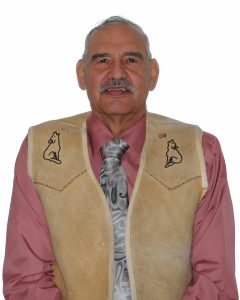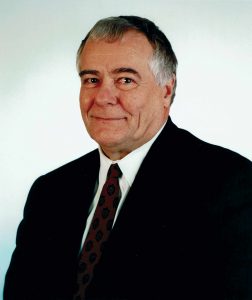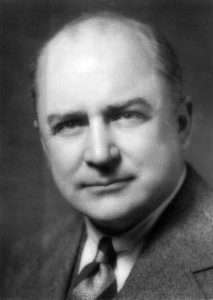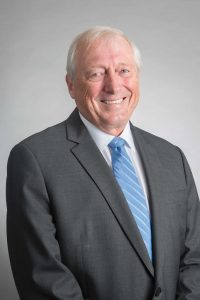In 2020, the Canadian Mining Hall of Fame will welcome four new inductees: P. Jerry Asp, Alex G. Balogh, Hans T.F. Lundberg and Eberhard (Ebe) Scherkus. The thirty-second annual induction dinner will take place on the evening of Jan. 9, 2020, in Constitution Hall at the Metro Toronto Convention Centre.
The Northern Miner is a cofounding sponsor of the Hall of Fame, along with the Canadian Institute of Mining, Metallurgy and Petroleum, the Mining Association of Canada and the Prospectors & Developers Association of Canada (PDAC). FOr more information, click here.
P. Jerry Asp (b. 1948)

P. Jerry AspP. Jerry Asp is one of Western Canada’s most prominent Indigenous leaders and a tireless advocate for the inclusion of Indigenous Peoples in the mining industry. His leadership skills came to the fore in the 1980s, during a mineral exploration and mining boom in the “Golden Triangle” of northwestern British Columbia.
As a chief and member of the Tahltan Nation, he understood his community’s concerns about development taking place on their traditional lands. Yet having worked in the mining industry since 1965, he also recognized the potential for employment and business opportunities, and to build skills and capacity in the community. In 1985, Asp founded the Tahltan Nation Development Corp. (TNDC) as GM and became president in 1987. His goal was to negotiate partnerships between TNDC and mining companies, starting with the Golden Bear mine, which required a 1.6 km access road across Tahltan territory. The concept was new at the time, but Asp negotiated the first impact benefit agreement in the province’s history, which included road construction and other contracts at Golden Bear.
TNDC went on to sign contracts at other mines, such as Eskay Creek and Red Chris, and became the largest native-owned and operated heavy construction company in Western Canada. The unemployment rate fell to almost zero in the 1990s and has remained low, as TNDC diversified to other sectors, such as road maintenance, hydroelectric power lines and “green energy” projects.
In recent years, Asp has focused on building bridges of understanding between the mining sector and Indigenous Peoples, and challenging misconceptions that hinder the reconciliation process. He is proud of the Tahltan’s history of mining and trading obsidian along the West Coast, and notes that his grandfather was a placer gold prospector. Asp is an advocate of skills training and apprenticeship programs, a legacy of his early years as an underground miner and driller, captain of a mine rescue team and president of the only all-native United Steelworkers’ local in North America. It was a natural progression for him to work with government and industry to create training and economic development opportunities for Indigenous Peoples in Canada and around the world. He was instrumental in developing the Aboriginal Toolkit for Mining, which won an award from the UN as the best educational document of its kind in 2007.
Asp was a founding member of what became the Canadian Aboriginal Minerals Association and served as its vice-president from 1991 to 2013. In 2014, he cofounded the Global Indigenous Development Trust to help educate and build alliances between Indigenous communities and mining companies around the world. Through this program, he has shared Canadian best practices for building partnerships between industry and Indigenous Peoples, with hundreds of Indigenous communities across 15 countries and five continents.
Asp has received many awards for his trailblazing role in helping to build inclusive relationships between the mining industry and Indigenous Peoples. In 2011, he was the recipient of PDAC’s prestigious Skookum Jim Award for his exceptional achievements. He was awarded the Queen Elizabeth II Diamond Jubilee Medal in 2013, followed by the Frank Woodside Past Presidents Distinguished Service Award by AME BC in 2015. In 2017, he received the Indspire Award in Business and Commerce, the highest honour the Indigenous community bestows on its own achievers.
Alex G. Balogh (b. 1932)
During an illustrious career spanning 50 years, Alex Balogh earned his place in a select group of industry leaders who shaped and built Noranda and Falconbridge into the most successful mining and metallurgical giants in Canadian history. He has the rare distinction of contributing to the growth of both companies, starting with Noranda, which he joined at Gaspé Copper in 1954 after earning a degree in metallurgical engineering from McGill University in his home city of Montreal, Quebec.

An early achievement while a shift foreman was the development while working with others of the now-famous “Gaspé puncher” that improved the operating efficiency and working conditions of copper converters. Heath & Sherwood subsequently licensed this machine worldwide. Another first as a civic activity and initially as a hobby was the founding with R. Ford of bilingual newspaper the Gaspe Peninsula Voyageur, which served the Gaspé region for over 15 years.
Balogh’s greatest contribution to the mining industry and to society was in the 1970s, with the introduction of Noranda’s continuous smelting and converting process at the Horne smelter in Quebec. This pioneering process improved energy and environmental efficiency, eliminated the emission of sulphur dioxide into the atmosphere — mitigating the “acid rain” issue — and ensured the longevity of the Horne smelter, which could treat a variety of feed materials as other smelters closed.
Balogh brought the same focus on responsible growth as he transitioned to executive positions at Noranda. He oversaw Noranda’s investment in Falconbridge in 1989, and served as president and CEO of both companies in the 1990s. He developed several major mines during this period — notably the Raglan nickel project in Quebec’s Ungava region. The main challenge facing the stalled project was the remote location and short window to move concentrates to an existing smelter. Balogh supported tests by a new ice-breaking vessel, which solved the shipping problem. The mine began in 1997. He encouraged innovative technology to maximize the value of the giant Collahuasi copper mine in Chile, and the Antamina copper-zinc mine in Peru.
Balogh was president and CEO of Falconbridge from 1989 to 1991, and chairman from 1994 to 2003. He was a senior executive at Noranda Mines from 1976 to 1988, president and CEO of Noranda Minerals from 1991 to 1994, and deputy chairman of Noranda Inc. from 1994 to 2003. During that time, Noranda enjoyed remarkable growth and had more than 30,000 employees worldwide by 1996, with total assets of almost $15 billion. The 2005 merger of Noranda and Falconbridge set the stage for one of the world’s largest mining and metallurgical conglomerates. While a wave of industry consolidation saw the merged entity acquired by a multinational miner a year later, the legacies of its builders and leaders live on and continue to benefit all Canadians.
After retirement Balogh served the mining sector as a consultant, corporate director, mentor of young geoscientists, and strong supporter of industry associations and causes. In 2002, he received the CIM Vale Medal for Meritorious Contributions to Mining “in recognition of his many contributions as a metallurgical engineer, operations manager, and executive in the development of technologies, which resulted in low-cost, environmentally sound operations for producing copper, zinc and nickel.”
Hans T. F. Lundberg (1893–1971)
Few people have done more to introduce science and technology to mineral exploration than Hans Lundberg, a visionary pioneer in the development and application of geophysical and geochemical methods in Canada and other parts of the world. He was the first to conduct ground geophysical surveys in Canada in the 1920s, which led to two major discoveries in the Buchans area of Newfoundland. He was the first to attempt geochemical prospecting in Canada, and the first to integrate geophysics and geochemistry into a multidisciplinary exploration strategy.

Lundberg’s greatest accomplishments were the first application of airborne geophysical methods in the 1940s, and his adaptations of geophysical instruments from aircraft. These ideas came from his early years in Sweden, where geophysics was emerging as a tool for finding buried mineral deposits. Lundberg graduated in 1917 from the Royal Institute of Technology, Stockholm, with a thesis entitled “Electrical prospecting.” The young civil engineer went on to develop a new variation of “equipotential” surveying that proved more sensitive and practical for field use in a cold climate, which resulted in two polymetallic discoveries in the Skelleftea District: Kristineberg in 1918, and Bjurfors in 1922. During this period he also experimented with instruments carried aloft by kites, gliders and large balloons, in the belief that aerial magnetic surveys would provide better access and faster coverage than ground surveys. It was not until 25 years later, after the Second World War, that his lofty dreams were realized.
Lundberg moved to Canada in 1926, became a citizen in 1936, and helped the government meet its strategic mineral resource requirements during the war. He had followed developments in aviation and electronics and was determined to pursue his vision of airborne geophysics once peace was declared. In 1946, he began aerial magnetic surveys into northern Ontario and Quebec, using one of the first commercial Bell helicopters in Canada. He saw the electromagnetic (EM) technique as the next logical geophysical method to deploy by aircraft, and in 1947, conducted trials of an EM system built inside a helicopter bubble. The system worked, albeit with low limits of coverage, and led to further advancements, such as mounting EM systems on fixed-wing aircraft. In the 1950s, Lundberg pioneered airborne radiometric surveying, which would prove invaluable to uranium exploration in subsequent decades.
While the geophysical methods introduced by Lundberg would be considered primitive by today’s standards, they did contribute to numerous discoveries, starting with the Lucky Strike and Oriental polymetallic discoveries at Buchans. These deposits accounted for half of the 56-year production history of this prolific mine. Lundberg’s pioneering use of biogeochemistry, lake-sediment sampling and boulder tracing also contributed to the success of Buchans. Despite these early successes, and discovery track record, Lundberg faced industry skepticism for his novel ideas and eclectic interests. In response, he wrote scientific papers, gave lectures, supported research, patented 20 inventions, and, more importantly, encouraged many young geophysicists and geochemists to advance these new branches of science. He left a legacy of discovery and innovation that was unparalleled in his lifetime, which earned him the reputation as Canada’s first ambassador of exploration.
Eberhard (Ebe) Scherkus (b. 1952)
The remarkable success and longevity of Agnico Eagle Mines (TSX: AEM; NYSE: AEM) owes much to Eberhard (“Ebe”) Scherkus, a multi-faceted geologist and professional engineer with a track record of achievement. He joined the company as a project manager in 1985, became chief operating officer (COO) in 1998, and was president and COO from 2005 until he retired in 2012. During this time he transformed Agnico Eagle from a regional single-mine company into a top-performing global gold producer, with nine mines in Canada, Finland and Mexico. He also earned a reputation as a generous career mentor, environmentally responsible industry leader, and a builder of bridges with Indigenous Peoples and other stakeholders in Canada and abroad.

Born in Germany, Scherkus came to Canada as an infant and was raised in Val-d’Or, Quebec. He earned his B.Sc. in geology from McGill University in 1975, and worked for several companies before joining Agnico Eagle. The company was then headed by legendary founder Paul Penna, who needed a technical team to turn around a struggling, low-grade, open-pit mine with limited reserves. Scherkus accepted the daunting challenge, transformed LaRonde into a productive mine, and subsequently expanded it at least four times. LaRonde’s 2.2 km Penna shaft is the deepest single-lift shaft in the Americas. As of 2017, the flagship mine had produced five million oz. gold, with another 2.6 million oz. in proven and probable reserves.
Scherkus developed the nearby Goldex and Lapa gold mines, as well as the Meadowbank gold project in Nunavut, which Agnico Eagle had acquired in 2007. Meadowbank was Agnico Eagle’s first Arctic mine, where the main difficulties were the remote location and harsh weather conditions. An impact benefit agreement was signed with the Kivalliq Inuit Association to ensure employment and business opportunities. Meadowbank poured its first gold in 2010, and had produced 2 million oz. gold by 2015, with nearly 250,000 oz. in 2018. More recently, Agnico Eagle opened the Meliadine gold mine to expand its presence in Nunavut.
Another phase of Agnico Eagle’s growth was outside of Canada, where the challenge was to adapt to new cultures while promoting corporate policies on responsible mine development. The Kittila mine in Finland and the Pinos Altos mine in Mexico both poured their first gold in 2009. Scherkus showed strong leadership during this period of growth by building highly skilled professional teams for each operation. The number of employees grew from 400 people at Canadian projects in 1985, to 5,700 people at mines and projects around the world when he retired. Since then, Scherkus has continued to contribute to the mining industry by serving as a director of numerous companies, and as a board member of industry associations.
Scherkus has received many awards and honours for his achievements, including the Viola McMillan Award from PDAC in 2000, and the Selwyn G. Blaylock Medal from CIM in 2005. He was a cowinner of The Northern Miner’s Person of the Year Award in 2007, and the 2011 recipient of the Nunavut Mining Symposium’s Mike Hine Award. Prior to being appointed to the Governors’ Circle of the Quebec Mining Association in 2014, Scherkus served as president of the association in 1994.
This article first appeared in The Northern Miner.
